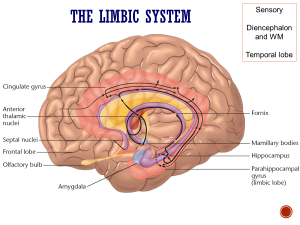Dr Tom Jenkins is a consultant neurologist and Senior Clinical Lecturer in Neurology at the Royal Hallamshire Hospital in Sheffield.
He observed that the difference between heart and mind is that the heart is just a pump whereas everything comes from the brain. The brain is the sphere of interest to the neurologist. Tom gave an example of his professional life: One Monday evening a 62 year old lady was admitted to the Hallamshire Hospital with sudden episodes of intense fear lasting seconds and occurring in full consciousness. This had been happening once every few weeks but was increasing in frequency recently. The neurological examination was normal. When asked the audience was rather reticent to suggest a reason. Tom explained that fear suggests a problem with the amygdala part of the brain. An MRI showed a tumour to the side of the amygdala causing focal seizures. He described this as an example of “neuroanatomical localisation in clinical neurology”, and his audience was reminded that Stumperlowe Probus has had some very bright speakers and Tom was one of them.
Tom continued to give a brief introduction to clinical neurology with a focus on the limbic system. Clinical Neurology is the branch of medicine concerned with disorders of the brain & nervous system. Tools at the Neurologist’s disposal are history (what people say); examination and investigations.
History includes the memory clinic. The richness of detail shows how functional a patient may be or how diminished due to dementia. Who comes to see the neurologist – if a patient is accompanied by someone this may be a sign of dementia. If a patient turns their head away during conversation is another dementia sign. Conversational analysis where the language structure is examined is another aspect.
Examination is a tool. It’s required when history doesn’t help. As an example, a 70-year-old man was admitted to hospital in a confused state. He couldn’t give an account of the problem and his family said he was walking round bumping into things. A neurological examination of his limbs was normal. He was not dysphasic (speech deficiency). He got up to go to the loo and it became apparent that he could not see. However, his ocular examination was normal. He was found to be confabulating to compensate for his lack of vision. The problem was cortical blindness due to a stroke. He had completely lost his sight and could not remember having sight.
Investigation is a large field of procedures. Lumber puncture or spinal tap has been around for some time. MRI scans are very important. Recently there has been an imaging revolution in neuroscience with 3D images on computer.
Neurophysiology is concerned with recording and interpreting electrical signals from the nervous system. It is important in the evaluation of peripheral nerve and brain function, often a key element in the diagnosis and assessment of diseases of the nervous system, such as epilepsy, muscle and peripheral nerve disease, sleep disorders or monitoring of nerve function. Electrodes are placed over the scalp to record activity. The process is called an electroencephalogram (EEG).
The Limbic System is a set of brain structures located on top of the brainstem and buried under the cortex. Limbic system structures are involved in many of our emotions and motivations, particularly those that are related to survival such as fear and anger. There are two perceptual areas: Memory and Emotion. The latter encompasses jealousy; anger; envy; embarrassment; disgust; fear; humour: love. These two areas combine to give drive-related behaviour like: to avoid danger; to fight for survival; to pass genes on; to protect one’s young and to gain benefits of social grouping. These are related to evolutionary benefit. Tom went into some detail about memory and dementia and the different areas of the brain involved.
For his audience’s age group, Tom’s talk was all too pertinent. It gave a structured background to a big subject that few laymen will be versed in. Tom’s grasp of the subject was most impressive.

